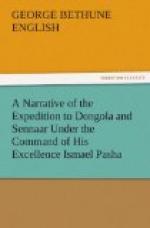[Footnote 11: About seventy miles above Wady Haifa.]
[Footnote 12: I cannot help smiling in copying off this part of my journal, at the little account I made of “bread rice and lentils,” at the commencement of the campaign. Before I left Sennaar, I have been more than once obliged to take a part of my horse’s rations of durra to support nature. He ate his portion raw and I boiled mine. The causes of such distress were that the natives of the Upper country would frequently refuse to sell us any thing for our dirty colored piastres of Egypt, and the Pasha would allow nobody to steal but himself. “Steal” a fico for the phrase. The wise “convey it call,” says ancient Pistol, an old soldier who had seen hard times in the wars.]
[Footnote 13: These were the rapids of Dall.]
[Footnote 14: In every dangerous pass, we invariably saw one or more of our boats wrecked.]
[Footnote 15: It is called Gamatee.]
[Footnote 16: The middle of the Upper Nile is generally occupied by an almost continued range of islands.]
[Footnote 17: I learned afterwards from Khalil Aga, the American, who accompanied me to Sennaar and back again to Egypt, and who visited tins spot, that this column made a part of the ruins of an ancient temple, where are to be seen two colossal statues. I set out the next day with him to visit this place, but being then only convalescent from a bloody flux which had reduced my strength, I found myself too weak to reach the place, and returned to the boat.]
[Footnote 18: The river continues in the same general direction as high up as the island of Mograt, on the Third Cataract, when it resumes a course more south and north. The length of this bend is probably not less than two hundred and fifty miles.]
[Footnote 19: i.e. The bank on our left-hand ascending the river.]
[Footnote 20: A more particular account of this battle will be given hereafter, in the course of the narrative.]
[Footnote 21: These gentlemen were Messrs. Waddington and Hanbury, who, after staying a short time in our camp, returned to Egypt. Mr. Waddington, on his return to England, published an account of his travels on the upper Nile, in which, having been misled by the tongue of some mischievous enemy of mine, he gave an account of me not a little fabulous. On my arrival in London, I wrote to Mr. Waddington what he was pleased to call a “manly and temperate letter,” informing him of his error, representing to him the serious injury it might do me, and calling upon him for a justification or an apology. Mr. Waddington, in the manner best becoming an English gentleman, frankly gave me both, concluding with the following expressions—“I feel the most sincere and profound sorrow for the unintentional injustice into which I have been betrayed by too hasty a belief of false information. For this I am as anxious to make you reparation, as I am incapable of doing




